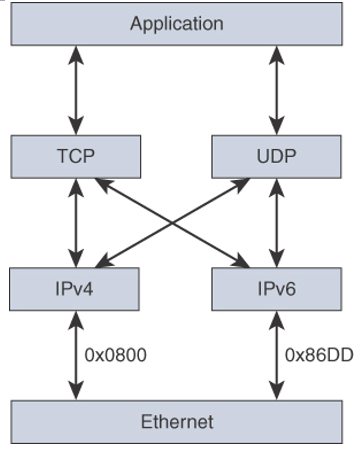Another method of IPv6 address allocation is to link a whole IPv4 address to the lowest significant bits of the IPv6 address. Table 2-11 shows an example using the same subnets as in Table 2-10. Converting the numbers, 172 decimal is 0xAC, and 16 is 0x10. The drawback with this schema is that it is not obvious that the IPv6 and IPv4 subnets are linked. At first sight, can you tell that 0xAC10 is 172.16?
Table 2-11 IPv6 Address Allocation Completely Linked to IPv4
| VLAN Number | IPv4 Subnet | IPv6 Subnet |
| VLAN 11 | 172.16.11.0/24 | 2001:DB8:ABC::AC10:0B:00/120 |
| VLAN 12 | 172.16.12.0/24 | 2001:DB8:ABC::AC10:0C00/120 |
| VLAN 13 | 172.16.13.0/24 | 2001:DB8:ABC::AC10:0D00/120 |
| VLAN 111 | 172.16.111.0/24 | 2001:DB8:ABC:AC10:6F00/120 |
| VLAN 112 | 172.16.112.0/24 | 2001:DB8:ABC:AC10:7000/120 |
| VLAN 113 | 172.16.113.0/24 | 2001:DB8:ABC:AC10:7100/120 |
IPv6 Addresses Allocated per Location and/or Type
Another schema for allocating IPv6 addresses is to assign bits to identify a location (such as a data center, core, edge, or branch) and/or other bits to identify a site type (such as a server, an end client, a router, or a switch). As shown in Figure 2-10, 4 bits can be used for location codes, and 4 additional bits used for type codes. The remaining bits of the /64 subnet can be used within the sites for specific VLANs.

Figure 2-10 IPv6 Address Allocated per Location/Type
IPv4-to-IPv6 Migration Strategies and Deployment Models
This section describes transition mechanisms and deployment models to migrate from IPv4 to IPv6. During a transition time, both protocols can coexist in the network. The three major migration strategies are
- Dual-stack: IPv4 and IPv6 coexist in hosts and networks.
- Tunneling: IPv6 packets are encapsulated into IPv4 packets.
- Translation: IPv6 packets are translated to IPv4 packets.
IPv6 deployment models are also divided into three major categories:
- Dual-stack model: IPv4 and IPv6 coexist on hosts and the network.
- Hybrid model: Combination of Intra-Site Automatic Tunneling Addressing Protocol (ISATAP) or manually configured tunnels and dual-stack mechanisms.
- Service block model: Combination of ISATAP and manually configured tunnels and dual-stack mechanisms.
Each model provides several advantages and disadvantages, and you should familiarize yourself with them. Of all these models, the dual-stack model is recommended because it requires no tunneling and is easiest to manage.
Dual-Stack Migration Strategy
Dual-stack is also referred to as native mode. Devices running dual-stack can communicate with both IPv4 and IPv6 devices. The IPv4 protocol stack is used between IPv4 hosts, and the IPv6 protocol stack is used between IPv6 hosts. An application decides which stack to use to communicate with destination hosts. Dual-stack is the recommended migration strategy when you migrate users by phases, allowing IPv6 users to access both IPv4 and IPv6 resources. As shown in Figure 2-11, when a frame is received, the Ethernet type code identifies whether the packet needs to be forwarded to IPv4 (0x0800) or IPv6 (ox86DD).

Figure 2-11 Dual-Stack Mechanism
When using dual-stack, the client uses DNS to determine which stack to use to reach a destination. If DNS returns an IPv6 (AAAA record) address to the client, the client uses the IPv6 stack. If DNS returns an IPv4 (A record) address to the client, the client uses the IPv4 stack. As mentioned before, operating systems such as Windows 11, macOS, and iOS, are configured to prefer IPv6 by default.